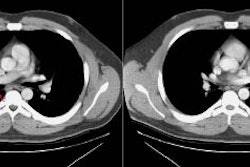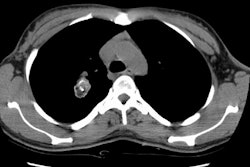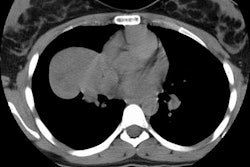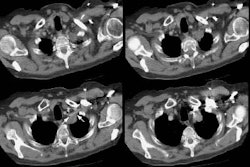AJR 1995 Nov;165(5):1119-1125. Pulmonary arteriovenous malformations: results of treatment with coil embolization in 53 patients.
Dutton JA, Jackson JE, Hughes JM, Whyte MK, Peters AM, Ussov W, Allison DJ
OBJECTIVE. The purpose of this study was to determine the effects of percutaneous transcatheter coil embolization of pulmonary arteriovenous malformations on arterial oxygen saturation, pulmonary gas exchange, anatomic right-to-left shunt, and lung function and to assess the complications of the procedure. SUBJECTS AND METHODS. Fifty-three patients were included in the study: 42 (79%) had associated hereditary hemorrhagic telangiectasia. Nineteen (36%) had neurologic problems compatible with paradoxical embolization. During 102 separate embolization procedures, all malformations with feeding vessels > or = 3 mm in diameter were embolized with steel coils. Arterial oxygen saturation at rest and on exercise and the intrapulmonary right-to-left shunt fraction (99mTc-macroaggregate injection), forced expiratory volume in 1 sec, vital capacity, diffusing capacity for carbon monoxide, and transfer coefficient were measured before and after embolization. Complications of the procedure were recorded and investigated. RESULTS. Before treatment, all patients had hypoxemia in the supine posture (SaO2, 89 +/- 1% [standard error of the mean]), which fell a further 6% (absolute) on standing. Mean values for transfer coefficient and diffusing capacity for carbon monoxide were reduced, at 85 +/- 3% and 78 +/- 3% (predicted value), respectively. After embolization, the mean values for supine and erect SaO2 rose to 94 +/- 1% and 93 +/- 1%. Transfer coefficient increased by a mean of 5.4% of predicted value. The mean shunt fraction fell from 23 +/- 2% preembolization to 9 +/- 1% postembolization. In 102 procedures, there were 18 complications, 12 mild, two moderate, and four potentially serious (systemic coil embolization in two patients, cerebrovascular accident [transient], and myocardial puncture), but there were no lasting sequelae. CONCLUSION. Our results show that coil embolization is an effective and well-tolerated method for treatment of pulmonary arteriovenous malformations. Improvements in pulmonary gas exchange and lung function and a decrease in right-to-left shunting occurred after treatment. The procedure was well tolerated and had a low complication rate.
PMID: 7572487, MUID: 96021939



